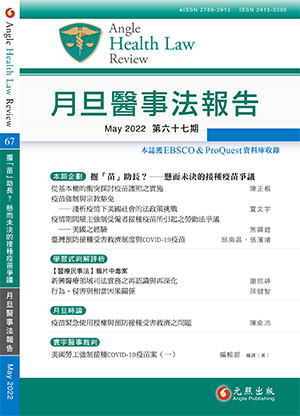毒性皮膚壞死症候群案判決之評析:以告知後同意與醫療行為過失為重心【醫法新論】 試閱
An Analysis of the Case of Toxic Epidermal Necrolysis (TEN): Focusing on Informed Consent Doctrine and Medical Negligence
本文藉由回顧最高法院106年度台上字第505號判決及其歷審判決,探討醫療行為過失與告知後同意各自的內涵與差異。在決定一個醫療行為有無過失時,應審視一個醫師從作成診斷、進行醫療處置到檢視評估處置之效果的過程,有無違反理性醫師之注意義務。而告知後同意則與醫療行為過失無關,其乃醫師將其醫療之固有風險,包含對病患之意思自主權、身體健康權造成侵害等移轉給病患承擔的過程,其概念上係侵權行為之阻卻違法事由,適用範圍不限於侵入性之手術或醫療。藉由整理醫療行為過失與告知後同意的概念及其法理後,本文重新檢視本件案例事實與判決之論理過程。本文認為,審查上應將「醫療行為過失有無而造成損害結果」與「有無踐行告知後同意」二者分別檢驗、論述。此外,應具體就整件醫療事件之時間軸上各點加以檢視,以明確化爭點。
By reviewing the Supreme Court Judgment No.505 (2017) and its procedural history, this article explores the connotations of medical negligence and the violation of informed consent doctrine. When determining the negligence of a physician, we should examine whether a physician has met the standard of a reasonable physician in the process of making a diagnosis, performing medical treatments, and evaluating the effect of the treatments. On the other hand, the doctrine of informed consent does not relate to medical negligence. It is a process in which a physician transfers the inherent risks of medical treatments, including the invasion of the right to autonomy and even body rights, to the patient. Conceptually, it serves as a justification or defense for tort liability, and is applicable in all sorts of medical treatments, not being limited to invasive medical procedures. By reviewing the concepts of medical negligence and informed consent doctrine, this article reexamines the facts and judgments of the case. It stresses the importance of discussing “whether there is a negligence that causes damage” and “whether the doctrine of informed consent has been generally implemented” separately. Besides, this article suggests that we should clarify issues by focusing specifically on each point on the timeline of the entire incident.
147-168






